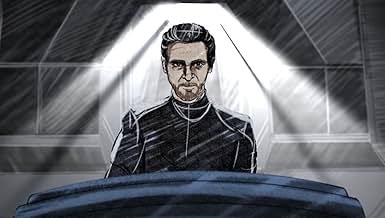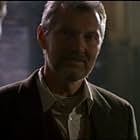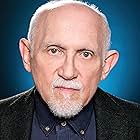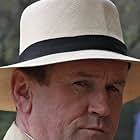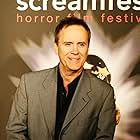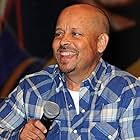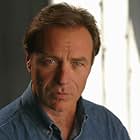What We Left Behind: Looking Back at Star Trek: Deep Space Nine
- 2018
- 1h 56m
IMDb RATING
8.3/10
2.3K
YOUR RATING
Ira Steven Behr explores the legacy of Star Trek: Deep Space Nine (1993).Ira Steven Behr explores the legacy of Star Trek: Deep Space Nine (1993).Ira Steven Behr explores the legacy of Star Trek: Deep Space Nine (1993).
Storyline
Did you know
- TriviaThis documentary marks the first time any footage from Star Trek: Deep Space Nine (1993) has been remastered in high definition. The filmmakers worked with CBS Digital to remaster thirty minutes of the original film negatives, and also reproduced a portion of the main battle sequence from Sacrifice of Angels (1997). The filmmakers have stated a goal of this project is to convince CBS to remaster Deep Space Nine in high definition.
- ConnectionsFeatures Star Trek (1966)
- SoundtracksI Left My Quark and Captain Sisko
Written by George Cory and Douglass Cross
New lyrics by Max Grodénchik
Performed by Max Grodénchik
Featured review
Premiering in syndication on January 3, 1993 and ending with the broadcast of its 176th episode on June 2, 1999, the thing that I loved most about Star Trek: Deep Space Nine (1993) was that it was something new for the Star Trek franchise. The Gene Roddenberry-created Star Trek (1966) and Star Trek: The Next Generation (1987) were both shows built around idealism, they were about exploration and diplomacy, about idealised characters, about how hope should never be lost. And then came Deep Space Nine, or, to use a moniker originally intended as derogatory, but which has since been appropriated as a badge of honour by the show's makers and fans, "dark Star Trek". And this moniker was not unearned - look at the sixth season episode "In the Pale Moonlight (1998)", regarded by some (myself included) as the finest hour of the entire Star Trek franchise, and by others as the episode where DS9 most egregiously violated the edicts of Roddenberry's creation; an episode in which Capt. Benjamin Sisko (the legendary Avery Brooks) lies, cheats, cajoles, and is a party to murder to ensure the Romulans join the Dominion War. And if that isn't bad enough, not only does he admit in his personal log that he would do it all again if he had to, he then erases the log entirely. This was psychological territory which raised the kind of moral questions one simply never encountered when dealing with such idealised characters as James T. Kirk and Jean-Luc Picard.
Although created by Rick Berman and Michael Piller, the real creative force was executive producer and lead writer Ira Steven Behr. Long before the Second Golden Age of Television, DS9 occupied a fascinating middle-ground between episodic storytelling and the serialisation format employed by most shows today. This is one of the reasons why it has proved so popular on Netflix in recent years - it lends itself to watching six or seven episodes at a time so as to get a better sense of the overarching narrative tapestry, a tapestry which TOS, TNG, and Star Trek: Voyager (1995) simply didn't have.
All of which brings us to What We Left Behind: Looking Back at Star Trek: Deep Space Nine, a partly fan-funded documentary directed by Behr and David Zappone. The first point, and one that I simply can't over-emphasise, is that it's worth the price of admission just for the 22 minutes of clips in glorious HD. TOS and TNG have already had their 1080p conversions, but DS9 has only ever been seen in 480i. With that in mind, the documentary offers a unique opportunity for fans to see parts of the show in full HD. Obviously, the space stuff looks truly amazing, with the epic battle scenes from "Sacrifice of Angels (1997)" standing up against anything you'd see in a big budget movie in terms of scope and elaborateness. However, even the smaller character moments really pop - the colours are so much richer (especially the reds and blues in the uniforms), the blacks and shadows so much deeper, the makeup more nuanced, the subtlety of background detail more noticeable. In a roundtable with Behr, Zappone, and producer/editors Joseph Kornbrodt and Luke Snailham, shown after the screening I attended, there are some split-screen comparisons between the clips as they originally aired and as they appear in the documentary, and it's like watching a completely different show.
The film begins with the cast reading extracts from some of the criticisms aimed at the show in its early years (how could it "boldly go" when it couldn't go anywhere, boldly or otherwise). And whilst these criticisms are played for laughs, Behr and Zappone don't shy away from looking at some of the more painful moments - Avery Brooks being forbidden from having a goatee and a shaved head, so as not to appear, to quote then Paramount Television chairman Kerry McCluggage, "too street"; Rick Berman not understanding why Behr wanted to introduce a war storyline, and later complaining that the show had become too violent; Terry Farrell asking to be written out of the show with only one season left because she felt she was being mistreated behind the scenes; the entire cast (except Colm Meaney) not being happy with the arrival of TNG's Michael Dorn in the fourth season; the psychological toll that playing Benny Russell in the sixth season masterpiece that is "Far Beyond the Stars (1998)" took on Avery Brooks.
The film also spends a lot of time looking at some of the series' more politically charged moments. Star Trek has always done political themes very well, but whereas TOS and TNG tended to operate via allegory and metaphor, DS9 was more direct. Terrorism, for example, was built into the show's DNA in the character of Major Kira Nerys (Nana Visitor), a former member of the Bajoran Resistance who had waged a guerrilla war against the Cardassian forces during the Occupation of Bajor, with the show depicting her as suffering from PTSD and crippling survivor guilt. It also reminds us how PTSD was addressed when Nog (Aron Eisenberg) lost a leg in battle. The film presents several military vets attesting how much it spoke to them to see DS9 handling such weighty themes with dignity and grace.
Another important theme was racism, which was addressed many times, but never more explicitly or more successfully than in "Far Beyond the Stars", which is set in 1953, depicting a writer, Benny Russell (played by Brooks), whose science fiction short stories are pulled from publication when word gets out that he's black, leading to what is hands down the most emotionally devastating and powerfully acted moment in the franchise's history. In relation to LGBTQ+ issues, the film points to the lesbian kiss in "Rejoined (1995)" and the long-rumoured but never confirmed theory that Garak (Andrew Robinson) was gay. Indeed, in relation to inclusivity, Behr laments that the show could have done better, arguing that one kiss and one rumour over seven years wasn't enough.
Elsewhere, an issue that illustrates just how little acknowledgement the show has gotten is the importance of black characters. DS9 was not the first TV show with a black lead, that was A Man Called Hawk (1989) (which starred none other than Avery Brooks), but it was the first show to regularly feature scenes with only black characters. When discussing this aspect of the show, Behr is unable to contain his frustration when he relates how an episode of That's So 90s (2012) pointed to Homicide: Life on the Street (1993) as being the first show to feature scenes of all black characters, never even mentioning DS9.
And with that said, if the film has an overriding theme, it's vindication; the sense that the choices the showrunners made, choices which were criticised and often not understood, have stood the test of time, with the show rightfully thought of today as unusually mature and progressive. Another example of this vindication concerns the three-part second season opener; "The Homecoming (1993)", "The Circle (1993)", and "The Siege (1993)". The first three-episode arc in Star Trek history, the idea was met with considerable resistance, with Paramount execs arguing that a three-parter would never work. However, as the show would go on to prove time and again (ultimately doing an unprecedented ten-episode arc in the last season), being on a space station rather than a ship lent itself to multi-episode storylines.
And one final point. The reveal of the "greatest moment in the history of DS9", which comes during the closing credits, is one of the most epic examples of Rickrolling you'll ever see (albeit with a DS9 twist).
In terms of problems, the most egregious example is the absence of Avery Brooks (there is some interview footage, but it's archival). This leaves a massive lacuna in the film, not just in a practical sense, but in an emotional one as well; he was the heart of the show (and the only actor to appear in all 176 episodes), so for him not to feature is massively disappointing. However, in the years after the show went off the air, Brooks (a tenured Professor of Theatre at Rutgers) has gradually retired from film and TV acting whilst also appearing at fewer and fewer Star Trek events, and obviously, Behr was unable to persuade him to appear here. Another problem is that with Behr conducting the interviews, there's a sense in which he lets both Berman and McCluggage off too easily, especially in relation to the Terry Farrell situation. Another small problem is that Behr occasionally "stops" the film to intercut scripted moments, usually involving himself. As the director and primary subject, this technique crosses the line into self-indulgence, and although the scenes are supposed to be humorous, they're nowhere near as funny as the off-the-cuff moments elsewhere, and are both structurally awkward and thematically unnecessary.
That aside, however, What We Left Behind is an exceptional documentary. DS9's reputation as the "dark Star Trek" is not unearned, but as the film reminds us, it was often bleak but never cynical, often pessimistic but never nihilistic. On the contrary, what the film does especially well is remind us just how humanistic the show really was, and that any bleakness or darkness was earned by the contrasting moments of levity and humanity, by the depth of the characters and their relationships with one another. The film is about what the makers of the show left behind, but so too is it about how the show changed the future of television. The interviews with the cast and crew really drive home just how much it changed their lives, whilst the clips of fans talking about why they love it so much illustrate the extent to which it touched people. And given that Deep Space Nine was so long maligned, considered the "middle child" of the Star Trek family, it's pleasantly ironic that What We Left Behind is about the love which the show has engendered.
Although created by Rick Berman and Michael Piller, the real creative force was executive producer and lead writer Ira Steven Behr. Long before the Second Golden Age of Television, DS9 occupied a fascinating middle-ground between episodic storytelling and the serialisation format employed by most shows today. This is one of the reasons why it has proved so popular on Netflix in recent years - it lends itself to watching six or seven episodes at a time so as to get a better sense of the overarching narrative tapestry, a tapestry which TOS, TNG, and Star Trek: Voyager (1995) simply didn't have.
All of which brings us to What We Left Behind: Looking Back at Star Trek: Deep Space Nine, a partly fan-funded documentary directed by Behr and David Zappone. The first point, and one that I simply can't over-emphasise, is that it's worth the price of admission just for the 22 minutes of clips in glorious HD. TOS and TNG have already had their 1080p conversions, but DS9 has only ever been seen in 480i. With that in mind, the documentary offers a unique opportunity for fans to see parts of the show in full HD. Obviously, the space stuff looks truly amazing, with the epic battle scenes from "Sacrifice of Angels (1997)" standing up against anything you'd see in a big budget movie in terms of scope and elaborateness. However, even the smaller character moments really pop - the colours are so much richer (especially the reds and blues in the uniforms), the blacks and shadows so much deeper, the makeup more nuanced, the subtlety of background detail more noticeable. In a roundtable with Behr, Zappone, and producer/editors Joseph Kornbrodt and Luke Snailham, shown after the screening I attended, there are some split-screen comparisons between the clips as they originally aired and as they appear in the documentary, and it's like watching a completely different show.
The film begins with the cast reading extracts from some of the criticisms aimed at the show in its early years (how could it "boldly go" when it couldn't go anywhere, boldly or otherwise). And whilst these criticisms are played for laughs, Behr and Zappone don't shy away from looking at some of the more painful moments - Avery Brooks being forbidden from having a goatee and a shaved head, so as not to appear, to quote then Paramount Television chairman Kerry McCluggage, "too street"; Rick Berman not understanding why Behr wanted to introduce a war storyline, and later complaining that the show had become too violent; Terry Farrell asking to be written out of the show with only one season left because she felt she was being mistreated behind the scenes; the entire cast (except Colm Meaney) not being happy with the arrival of TNG's Michael Dorn in the fourth season; the psychological toll that playing Benny Russell in the sixth season masterpiece that is "Far Beyond the Stars (1998)" took on Avery Brooks.
The film also spends a lot of time looking at some of the series' more politically charged moments. Star Trek has always done political themes very well, but whereas TOS and TNG tended to operate via allegory and metaphor, DS9 was more direct. Terrorism, for example, was built into the show's DNA in the character of Major Kira Nerys (Nana Visitor), a former member of the Bajoran Resistance who had waged a guerrilla war against the Cardassian forces during the Occupation of Bajor, with the show depicting her as suffering from PTSD and crippling survivor guilt. It also reminds us how PTSD was addressed when Nog (Aron Eisenberg) lost a leg in battle. The film presents several military vets attesting how much it spoke to them to see DS9 handling such weighty themes with dignity and grace.
Another important theme was racism, which was addressed many times, but never more explicitly or more successfully than in "Far Beyond the Stars", which is set in 1953, depicting a writer, Benny Russell (played by Brooks), whose science fiction short stories are pulled from publication when word gets out that he's black, leading to what is hands down the most emotionally devastating and powerfully acted moment in the franchise's history. In relation to LGBTQ+ issues, the film points to the lesbian kiss in "Rejoined (1995)" and the long-rumoured but never confirmed theory that Garak (Andrew Robinson) was gay. Indeed, in relation to inclusivity, Behr laments that the show could have done better, arguing that one kiss and one rumour over seven years wasn't enough.
Elsewhere, an issue that illustrates just how little acknowledgement the show has gotten is the importance of black characters. DS9 was not the first TV show with a black lead, that was A Man Called Hawk (1989) (which starred none other than Avery Brooks), but it was the first show to regularly feature scenes with only black characters. When discussing this aspect of the show, Behr is unable to contain his frustration when he relates how an episode of That's So 90s (2012) pointed to Homicide: Life on the Street (1993) as being the first show to feature scenes of all black characters, never even mentioning DS9.
And with that said, if the film has an overriding theme, it's vindication; the sense that the choices the showrunners made, choices which were criticised and often not understood, have stood the test of time, with the show rightfully thought of today as unusually mature and progressive. Another example of this vindication concerns the three-part second season opener; "The Homecoming (1993)", "The Circle (1993)", and "The Siege (1993)". The first three-episode arc in Star Trek history, the idea was met with considerable resistance, with Paramount execs arguing that a three-parter would never work. However, as the show would go on to prove time and again (ultimately doing an unprecedented ten-episode arc in the last season), being on a space station rather than a ship lent itself to multi-episode storylines.
And one final point. The reveal of the "greatest moment in the history of DS9", which comes during the closing credits, is one of the most epic examples of Rickrolling you'll ever see (albeit with a DS9 twist).
In terms of problems, the most egregious example is the absence of Avery Brooks (there is some interview footage, but it's archival). This leaves a massive lacuna in the film, not just in a practical sense, but in an emotional one as well; he was the heart of the show (and the only actor to appear in all 176 episodes), so for him not to feature is massively disappointing. However, in the years after the show went off the air, Brooks (a tenured Professor of Theatre at Rutgers) has gradually retired from film and TV acting whilst also appearing at fewer and fewer Star Trek events, and obviously, Behr was unable to persuade him to appear here. Another problem is that with Behr conducting the interviews, there's a sense in which he lets both Berman and McCluggage off too easily, especially in relation to the Terry Farrell situation. Another small problem is that Behr occasionally "stops" the film to intercut scripted moments, usually involving himself. As the director and primary subject, this technique crosses the line into self-indulgence, and although the scenes are supposed to be humorous, they're nowhere near as funny as the off-the-cuff moments elsewhere, and are both structurally awkward and thematically unnecessary.
That aside, however, What We Left Behind is an exceptional documentary. DS9's reputation as the "dark Star Trek" is not unearned, but as the film reminds us, it was often bleak but never cynical, often pessimistic but never nihilistic. On the contrary, what the film does especially well is remind us just how humanistic the show really was, and that any bleakness or darkness was earned by the contrasting moments of levity and humanity, by the depth of the characters and their relationships with one another. The film is about what the makers of the show left behind, but so too is it about how the show changed the future of television. The interviews with the cast and crew really drive home just how much it changed their lives, whilst the clips of fans talking about why they love it so much illustrate the extent to which it touched people. And given that Deep Space Nine was so long maligned, considered the "middle child" of the Star Trek family, it's pleasantly ironic that What We Left Behind is about the love which the show has engendered.
Details
- Release date
- Country of origin
- Official sites
- Language
- Also known as
- DS9: What We Left Behind
- Production companies
- See more company credits at IMDbPro
Box office
- Gross US & Canada
- $382,457
- Gross worldwide
- $434,437
Contribute to this page
Suggest an edit or add missing content

Top Gap
By what name was What We Left Behind: Looking Back at Star Trek: Deep Space Nine (2018) officially released in Canada in English?
Answer

